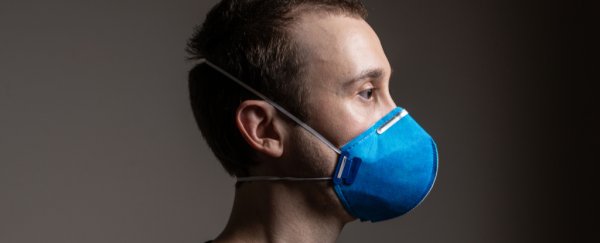Masks have become a defining icon of the COVID-19 pandemic, in spite of some confusing advice about what people should and shouldn't be wearing.
While face coverings may offer minimal protection to the individuals wearing them (with some doctors saying they aren't nearly as effective as we might think), other experts recommend their use, suggesting that if enough people wear masks, it will ultimately save lives, by helping to reduce transmission of infection from those wearing masks.
In a best-case scenario, we'd all have a medical-grade N95 respirator to sift out 95 percent of nano-sized aerosols and particles. Yet, even then, research shows very few of us actually know how to strap them on correctly.
One study performed after Hurricane Katrina found only 24 percent of public participants wore these kinds of masks properly.
Now, a more recent survey from Singapore, led by researchers from the National University Hospital, has found that just one in eight participants know how to don these masks effectively.
"These findings support ongoing recommendations against the use of N95 masks by the general public during the COVID-19 pandemic," the authors write.
"N95 mask use by the general public may not translate into effective protection but instead provide false reassurance."
Those who are wearing masks, for example, might feel as though they no longer need to socially distance themselves from other people around them.
If so, that could be a dangerous assumption. The World Health Organisation (WHO) says there is "currently no evidence that wearing a mask (whether medical or other types) by healthy persons in the wider community setting, including universal community masking, can prevent them from infection with respiratory viruses, including COVID-19".
On the other hand, the potential for mask-wearing to limit transfer of the virus to others has let to many countries recommending or requiring the use of masks when people are in public places.
In the US, the Centres for Disease Control and Prevention (CDC) recommends the public use cloth coverings to "slow the spread of the virus and help [prevent] people who may have the virus and do not know it from transmitting it to others".
Importantly, the CDC asks the public not to use medical masks or N95 respirators, as these are critical for healthcare workers and first responders, and in short supply.
Another factor to consider in all this is the public's ability to wear medical-grade masks properly, evidenced in part at least by the new study.
In 2014, members of the Singaporean public were mailed N95 masks with pictorial instructions as part of an emergency preparedness program for severe episodes of air pollution.
A cross sectional study a year later received feedback from 714 randomly picked adults, who had been asked to put on the mask with no prompting from the instruction sheet.
The interviewers then checked the mask's fit, and conducted a seal check, where the participant is asked to exhale in and out, while the edges of the mask are watched.
In the end, only 12.6 percent of people actually passed the test, meaning most people hadn't fitted their masks properly. Even those who had been mailed the instruction leaflet, and who had owned the mask beforehand, were just as likely to fail.
The biggest mistakes were misplacing the straps, leaving a gap between the mask and the skin, and failing to tighten the nose grip.
Given the masks are designed with valves and filters to reliably screen out all but a slim percentage of tiny airborne particles coming into your lungs, it's hard to say how well they would function if worn too loosely.
Of course, this is only for N95 masks, which are a bit trickier to wear than surgical masks. Further research will be needed to see how the public copes with those coverings.
"Policy measures that encourage mask use in the general public must be coupled with effective training materials beyond instruction leaflets, which our study and a 2013 study found to be inadequate," the authors write.
"Other public health measures, such as social distancing, handwashing, and self-isolation when ill, are also critical."
The study was published in JAMA Network Open.
